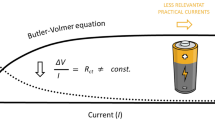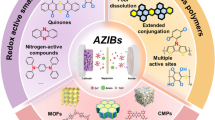Abstract
The electrochemical behavior of a platinum electrode in a set of 1-alkyl ether (and 1-alkyl)-3-methylimidazolium room-temperature ionic liquids (RTILs) 1–3 ([CxOyMim]+[Anion]− or [CxMim]+[Anion]−, where Mim = 3-methylimidazolium; CxOy = 1-alkyl ether; C7O3 = -(CH2)2O(CH2)2O(CH2)2OCH3; C3O1 = -(CH2)2OCH3; Cx = 1-alkyl; C10 = C10H21; C4 = C4H9; and \( {\left[ {{\text{Anion}}} \right]}^{ - } = {\text{H}}_{3} {\text{CSO}}^{ - }_{3} ,{\text{ BF}}^{ - }_{4} {\text{, or PF}}^{ - }_{6} \)) was studied by cyclic voltammetry and electrical conductivity. This complementary set of imidazolium RTILs allowed us to explore the effect of the imidazolium cation and the counter-ion, both of which affected the electrochemical window of these RTILs. Various electrochemical events with low current values were observed, which diminished the electrochemical windows. Interestingly, RTILs 2b [1-(2-methoxyethyl)-3-methylimidazolium tetrafluoroborate] and 2d [1-butyl-3-methylimidazolium tetrafluoroborate] showed quasireversible charge transfer processes. The length of the functional group attached to the imidazolium cation was shown to be of great influence as larger electrochemical windows, as well as lower electrical conductivities, were obtained with the longer C7O3 and C10 functional groups. The largest electrochemical window of 2.0 V was achieved with RTIL 2c, 1-decyl-3-methylimidazolium tetrafluoroborate.






Similar content being viewed by others
References
Dupont J, Consorti CS, Spencer J (2000) J Braz Chem Soc 11:337
Dupont J, Souza RF, Suarez PAZ (2002) Chem Rev 102:3667
Welton T (1999) Chem Rev 99:2071
Astruc D, Lu F, Aranzaes JR (2005) Angew Chem 117:8062
Astruc D, Lu F, Aranzaes JR (2005) Angew Chem Int Ed Engl 44:7852
Migowski P, Dupont J (2007) Chem Eur J 13:32
Yang Z, Pan W (2005) Enzyme Microb Technol 37:19
Souza RF, Padilha JC, Gonçalves RS, Dupont J (2003) Electrochem Commun 5:728
Souza RF, Padilha JC, Gonçalves RS, Rault-Berthelot J (2006) Electrochem Commun 8:211
Abedin SZE, Endres F (2006) ChemPhysChem 7:58
Lee SG (2006) Chem Commun 10:1049
Davis JH (2004) Chem Lett 33:1072
Fei ZF, Geldbach TJ, Zhao DB, Dyson PJ (2006) Chem Eur J 12:2122
Branco LC, Rosa JN, Ramos JJM, Afonso CAM (2002) Chem Eur J 8:3671
Schrekker HS, Gelesky MA, Stracke MP, Silva DO, Schrekker CML, Dupont J (in preparation) J Braz Chem Soc
Cassol CC, Ebeling G, Ferrera B, Dupont J (2006) Adv Synth Catal 348:243
Xiao L, Johnson KE (2003) J Electrochem Soc 150:E307
Santos VO, Alves MB, Carvalho MS, Suarez PAZ, Rubim JC (2006) J Phys Chem B 110:20379
da Silveira Neto BA, Ebeling G, Gonçalves RS, Gozzo FC, Eberlin MN, Dupont J (2004) Synthesis 8:1155
Rivera-Rubero S, Baldelli S (2004) J Phys Chem B 108:15133
Suarez PAZ, Selbach VM, Dullius JEL, Einloft S, Piatnicki CMS, Azambuja DS, Souza RF, Dupont J (1997) Electrochim Acta 42:2533
Magnussen OM (2002) Chem Rev 102:679
Suarez PAZ, Einloft S, Dullius JEL, Souza RF, Dupont J (1998) J Chim Phys 95:1626
Dupont J, Suarez PAZ (2006) Phys Chem Chem Phys 8:2441
Consorti CS, Suarez PAZ, de Souza RF, Burrow RA, Farrar DH, Lough AJ, Loh W, da Silva LHM, Dupont J (2005) J Phys Chem B 109:4341
Acknowledgments
The authors thank the CNPq for financial support. H.S.S. thanks the CNPq for a visiting scientist fellowship.
Author information
Authors and Affiliations
Corresponding author
Additional information
Dedicated to the memory of Prof. Francisco Nart.
Rights and permissions
About this article
Cite this article
Donato, R.K., Migliorini, M.V., Benvegnú, M.A. et al. The electrochemical properties of a platinum electrode in functionalized room temperature imidazolium ionic liquids. J Solid State Electrochem 11, 1481–1487 (2007). https://doi.org/10.1007/s10008-007-0304-6
Received:
Revised:
Accepted:
Published:
Issue Date:
DOI: https://doi.org/10.1007/s10008-007-0304-6




